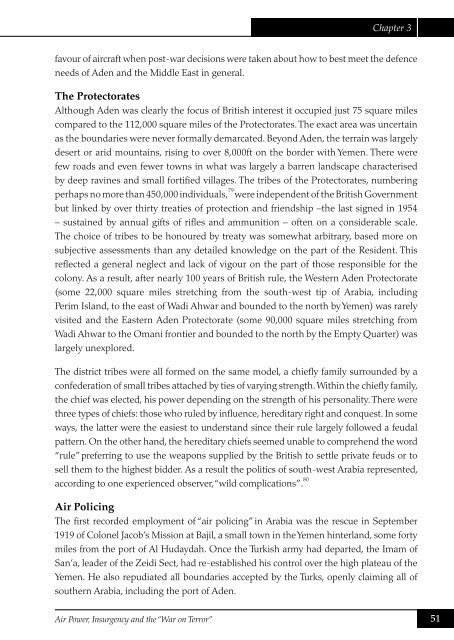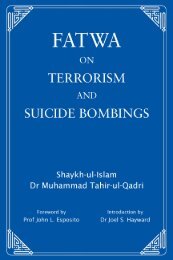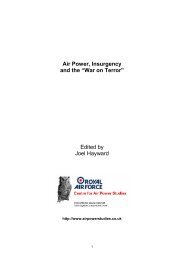Air Power, Insurgency and the âWar on Terrorâ - Prof. Joel Hayward's ...
Air Power, Insurgency and the âWar on Terrorâ - Prof. Joel Hayward's ...
Air Power, Insurgency and the âWar on Terrorâ - Prof. Joel Hayward's ...
You also want an ePaper? Increase the reach of your titles
YUMPU automatically turns print PDFs into web optimized ePapers that Google loves.
Chapter 3<br />
favour of aircraft when post-war decisi<strong>on</strong>s were taken about how to best meet <str<strong>on</strong>g>the</str<strong>on</strong>g> defence<br />
needs of Aden <str<strong>on</strong>g>and</str<strong>on</strong>g> <str<strong>on</strong>g>the</str<strong>on</strong>g> Middle East in general.<br />
The Protectorates<br />
Although Aden was clearly <str<strong>on</strong>g>the</str<strong>on</strong>g> focus of British interest it occupied just 75 square miles<br />
compared to <str<strong>on</strong>g>the</str<strong>on</strong>g> 112,000 square miles of <str<strong>on</strong>g>the</str<strong>on</strong>g> Protectorates. The exact area was uncertain<br />
as <str<strong>on</strong>g>the</str<strong>on</strong>g> boundaries were never formally demarcated. Bey<strong>on</strong>d Aden, <str<strong>on</strong>g>the</str<strong>on</strong>g> terrain was largely<br />
desert or arid mountains, rising to over 8,000ft <strong>on</strong> <str<strong>on</strong>g>the</str<strong>on</strong>g> border with Yemen. There were<br />
few roads <str<strong>on</strong>g>and</str<strong>on</strong>g> even fewer towns in what was largely a barren l<str<strong>on</strong>g>and</str<strong>on</strong>g>scape characterised<br />
by deep ravines <str<strong>on</strong>g>and</str<strong>on</strong>g> small fortified villages. The tribes of <str<strong>on</strong>g>the</str<strong>on</strong>g> Protectorates, numbering<br />
perhaps no more than 450,000 individuals, 79 were independent of <str<strong>on</strong>g>the</str<strong>on</strong>g> British Government<br />
but linked by over thirty treaties of protecti<strong>on</strong> <str<strong>on</strong>g>and</str<strong>on</strong>g> friendship –<str<strong>on</strong>g>the</str<strong>on</strong>g> last signed in 1954<br />
– sustained by annual gifts of rifles <str<strong>on</strong>g>and</str<strong>on</strong>g> ammuniti<strong>on</strong> – often <strong>on</strong> a c<strong>on</strong>siderable scale.<br />
The choice of tribes to be h<strong>on</strong>oured by treaty was somewhat arbitrary, based more <strong>on</strong><br />
subjective assessments than any detailed knowledge <strong>on</strong> <str<strong>on</strong>g>the</str<strong>on</strong>g> part of <str<strong>on</strong>g>the</str<strong>on</strong>g> Resident. This<br />
reflected a general neglect <str<strong>on</strong>g>and</str<strong>on</strong>g> lack of vigour <strong>on</strong> <str<strong>on</strong>g>the</str<strong>on</strong>g> part of those resp<strong>on</strong>sible for <str<strong>on</strong>g>the</str<strong>on</strong>g><br />
col<strong>on</strong>y. As a result, after nearly 100 years of British rule, <str<strong>on</strong>g>the</str<strong>on</strong>g> Western Aden Protectorate<br />
(some 22,000 square miles stretching from <str<strong>on</strong>g>the</str<strong>on</strong>g> south-west tip of Arabia, including<br />
Perim Isl<str<strong>on</strong>g>and</str<strong>on</strong>g>, to <str<strong>on</strong>g>the</str<strong>on</strong>g> east of Wadi Ahwar <str<strong>on</strong>g>and</str<strong>on</strong>g> bounded to <str<strong>on</strong>g>the</str<strong>on</strong>g> north by Yemen) was rarely<br />
visited <str<strong>on</strong>g>and</str<strong>on</strong>g> <str<strong>on</strong>g>the</str<strong>on</strong>g> Eastern Aden Protectorate (some 90,000 square miles stretching from<br />
Wadi Ahwar to <str<strong>on</strong>g>the</str<strong>on</strong>g> Omani fr<strong>on</strong>tier <str<strong>on</strong>g>and</str<strong>on</strong>g> bounded to <str<strong>on</strong>g>the</str<strong>on</strong>g> north by <str<strong>on</strong>g>the</str<strong>on</strong>g> Empty Quarter) was<br />
largely unexplored.<br />
The district tribes were all formed <strong>on</strong> <str<strong>on</strong>g>the</str<strong>on</strong>g> same model, a chiefly family surrounded by a<br />
c<strong>on</strong>federati<strong>on</strong> of small tribes attached by ties of varying strength. Within <str<strong>on</strong>g>the</str<strong>on</strong>g> chiefly family,<br />
<str<strong>on</strong>g>the</str<strong>on</strong>g> chief was elected, his power depending <strong>on</strong> <str<strong>on</strong>g>the</str<strong>on</strong>g> strength of his pers<strong>on</strong>ality. There were<br />
three types of chiefs: those who ruled by influence, hereditary right <str<strong>on</strong>g>and</str<strong>on</strong>g> c<strong>on</strong>quest. In some<br />
ways, <str<strong>on</strong>g>the</str<strong>on</strong>g> latter were <str<strong>on</strong>g>the</str<strong>on</strong>g> easiest to underst<str<strong>on</strong>g>and</str<strong>on</strong>g> since <str<strong>on</strong>g>the</str<strong>on</strong>g>ir rule largely followed a feudal<br />
pattern. On <str<strong>on</strong>g>the</str<strong>on</strong>g> o<str<strong>on</strong>g>the</str<strong>on</strong>g>r h<str<strong>on</strong>g>and</str<strong>on</strong>g>, <str<strong>on</strong>g>the</str<strong>on</strong>g> hereditary chiefs seemed unable to comprehend <str<strong>on</strong>g>the</str<strong>on</strong>g> word<br />
“rule” preferring to use <str<strong>on</strong>g>the</str<strong>on</strong>g> weap<strong>on</strong>s supplied by <str<strong>on</strong>g>the</str<strong>on</strong>g> British to settle private feuds or to<br />
sell <str<strong>on</strong>g>the</str<strong>on</strong>g>m to <str<strong>on</strong>g>the</str<strong>on</strong>g> highest bidder. As a result <str<strong>on</strong>g>the</str<strong>on</strong>g> politics of south-west Arabia represented,<br />
according to <strong>on</strong>e experienced observer, “wild complicati<strong>on</strong>s”. 80<br />
<str<strong>on</strong>g>Air</str<strong>on</strong>g> Policing<br />
The first recorded employment of “air policing” in Arabia was <str<strong>on</strong>g>the</str<strong>on</strong>g> rescue in September<br />
1919 of Col<strong>on</strong>el Jacob’s Missi<strong>on</strong> at Bajil, a small town in <str<strong>on</strong>g>the</str<strong>on</strong>g> Yemen hinterl<str<strong>on</strong>g>and</str<strong>on</strong>g>, some forty<br />
miles from <str<strong>on</strong>g>the</str<strong>on</strong>g> port of Al Hudaydah. Once <str<strong>on</strong>g>the</str<strong>on</strong>g> Turkish army had departed, <str<strong>on</strong>g>the</str<strong>on</strong>g> Imam of<br />
San’a, leader of <str<strong>on</strong>g>the</str<strong>on</strong>g> Zeidi Sect, had re-established his c<strong>on</strong>trol over <str<strong>on</strong>g>the</str<strong>on</strong>g> high plateau of <str<strong>on</strong>g>the</str<strong>on</strong>g><br />
Yemen. He also repudiated all boundaries accepted by <str<strong>on</strong>g>the</str<strong>on</strong>g> Turks, openly claiming all of<br />
sou<str<strong>on</strong>g>the</str<strong>on</strong>g>rn Arabia, including <str<strong>on</strong>g>the</str<strong>on</strong>g> port of Aden.<br />
<str<strong>on</strong>g>Air</str<strong>on</strong>g> <str<strong>on</strong>g>Power</str<strong>on</strong>g>, <str<strong>on</strong>g>Insurgency</str<strong>on</strong>g> <str<strong>on</strong>g>and</str<strong>on</strong>g> <str<strong>on</strong>g>the</str<strong>on</strong>g> “War <strong>on</strong> Terror” 51





